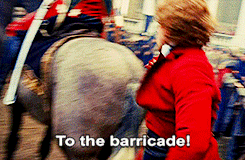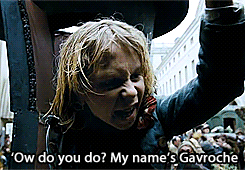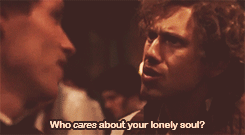It’s no secret that I am a huge Les Mis fan, or “Mizzie”. I have every single official English language recording of the show (Original London, Original Broadway, Complete Symphonic, Tenth Anniversary, Twenty First Anniversary, Twenty-fifth Anniversary, and Movie Deluxe Soundtrack) and I have official recordings in seven other languages as well. (French, Spanish, Japanese, German, Polish, Israeli, and Swedish). I dramaturged my production of it because of my extensive Les Mis knowledge, and memorized it to the point that during rehearsal I filled in for missing cast members without skipping a beat. (Not to mention entertaining/annoying my cast members with a series of two four six oh puns. I kept it up for the entire two four six oh run. I think towards the end there I started to get two four six oh shunned-but that wouldn’t stop my two four six oh fun).
(My Production. Photo credit to Andrew Richmond).
However, my love for Les Mis doesn’t end there. I’ve made it a life goal to immerse myself in every rendition of this story available. So far I’ve been fairly successful, I have six movie adaptations under my belt, seven if you count the 2012 movie-musical version, and I’ve watched all the episodes of the Les Mis anime Shoujo Cosette. (Japanese, I’m told, for A Girl Named Cosette). Back in middle school, I even took it upon myself to read the original novel by Victor Hugo. (Two for six oh-UN-abridged). The book, or the brick, as so many people refer to it since the book is about the same size and shape of a brick, is the novel that started it all, and the original source material for every adaptation, and is one of my personal favorite book of all time.
So, I’m pretty versed in both the original story and various adaptations of it as well. During my time doing the show, I had several conversations with people about the differences in various adaptations. Over a year after the show closed *sobs* this continued with my fellow theatre people. It was during Mary Poppins, talking to a couple of cast mates on closing day about the book, that it occurred to me “this would be a good topic for my theatre blog!”
Since this is a theatre blog, I will mainly be writing about the differences and similarities between the musical and the book, but I will also be touching on other versions as well. So before we start, here are the versions besides the original book and/or musical that I personally am familiar with and a brief description.
1934 version (Or as I call it, five hour French version)
I believe this is the first film adaptation of Les Mis, and it’s a silent film. Black and white, five hours long, French film directed by Raymond Bernard. Very thorough, very accurate to the original source material
1935 version (Or, the first English black and white version)
Relatively accurate to the text. Little Cosette actually had a personality, and her father died instead of abandoning them. Cosette and Fantine are actually reunited before Fantine dies, which is actually really charming. And Valjean actually keeps Cosette in the know of why they’re running all the time. But Gavroche isn’t in this version, which in my eyes is unforgiveable.
1952 version (Or the second black and white English version)
Relatively similar to the 1938 version. In fact, to refresh my memory I had to go back and watch them both to distinguish them in my mind. The more accurate of the two.
1958 version (Or the two hour color French version)
Another French version, this one’s in color and is much shorter, but still pretty accurate to the book. Eponine is a ginger.
1978 (Or, the Anthony Perkins version)
One of the shorter versions, made for TV movie. Anthony Perkins plays Javert. Color. Anthony Perkins is one of the best non-musical Javerts I’ve ever seen.
1998 version
Stars Liam Neeson as Valjean, Geoffrey Rush as Javert, Uma Thurman as Fantine, and Claire Danes as Cosette. This version is awesome and very true to the book….until Cosette grows up. Once Cosette grows up it kind of goes to heck. (And I just hate the way Claire Danes portrays her). The rest of the acting is excellent, though! Work watching at least once, but I almost never watch past Cosette growing up.
2012 film
This is arguably the most well-known version, and certainly the most recent film version (at least that I know of!). It is the only one based on the musical rather than the book. (Yes, I’m aware there are the concert versions of the show you can buy on DVD, but those are filmed stage productions rather than motion pictures). What I love about this version is that includes a lot of things that were in the book, but not in the musical. (Eponine dying to save Marius, the chase scene with Javert, Valjean and little Cosette, etc.)
Shoujo Cosette
The Les Mis anime. Pretty darn close to the original novel. Major differences are that it puts Cosette as the main character rather than Valjean, and it’s aimed at a younger audience so a few of the darker elements are removed. (For more on Shoujo Cosette, check out this video done by the brilliant Jess Daniels. Also worth checking out is a series of Shoujo Cosette videos paired to music from the musical.)
Les Miserables manga
Just like it sounds, a manga adaptation of the novel. Of every adaptation, I would say this one is the most faithful because it unapologetically came from Hugo’s text. Obviously it’s condensed, but the overall story and characterization is extremely faithful. My only real complaint is that you don’t see much of Gavroche.
Clear as mud? Okay, let’s dive in! I’ve divided the major differences into sections. Some of them overlap, so I jump around a bit, but I did my best to make it all make sense. If anything is unclear, feel free to drop a comment and I will answer to the best of my ability.
The Revolution/The Barricade Boys
Okay, for starters, the revolution that takes place in Les Mis is the June Rebellion, not The French Revolution. (Seriously!)
The June Rebellion took place after the French Revolution, and after Napoleon for that matter too. (In fact, several characters, including Thenardier and Marius’s father fought under Napoleon at the Battle of Waterloo-more about that later). This portion of the book was inspired by Victor Hugo’s experience with the real June Rebellion that took place between June fifth and sixth in 1832. Hugo was actually there for that, so some of the stuff he writes about the barricade boys is based on truth. We’ll never know for sure what parts are real and what’s fiction, which is both mesmerizing and frustrating as heck.
In the book, Victor Hugo takes an extensively long time giving the reader a history lesson of all the French history along with some social commentary. I’ll give you the brief version. French Revolution tried to abolish the monarchy. After Napoleon is defeated, the monarchy makes a return and brings social collapse with it, leaving the majority of the population….well, miserable. So the barricade boys decide to protest the monarchy, ergo the barricade. In real life, as in the book, as in the musical, they decide to take action at the funeral of General Lamarque. (Yes, he’s real!) Lamarque was loved by everyone, and the only true person in power who was an ally to the poor, so the barricade boys attack at his funeral, and then make a barricade outside the Café Musain, their meeting place. That would have been pretty hard to stage so Lamarque’s funeral isn’t in the musical, but it does make it to most film versions. Obviously this isn’t as clear in the show since people over and over try to say that it happened during the French Revolution. (But then again, the musical is already three hours long, so I guess the Boubil and Schonberg didn’t want to take the time to explain everything as the book did).
Also in the book, the barricade boys are much more developed and well written, with page long descriptions accompanying each one. As a group, they are referred to as a whole as either the Les Amis, ABC (pronounced abaisse) Society, or the barricade boys by the fandom. They meet in the Café Musain with the purpose of raising up the underdog, specifically the poor and underrepresented in society. Hugo talks about them being a group “which barely missed becoming historic”, and I couldn’t agree more. Much like in the musical, they are led by Enjolras (It’s no secret that he’s my favorite)…
…who is described as “a charming young man who was capable of being a terror”. (Here is a video of the marvelous Aaron Tveit, who played Enjolras in the 2012 film explaining how to say his name).
). From there we have Combefere (Cowm-fair) who assists Enjolras as the logic of the group, and Courfeyrac (Coo-Feh-Rawk) as the emotional core of the group. Together, they are the triumvirate of the chief, center, and guide. This is hinted at in the show, but not taken into fruition. The rest of the group consists of Jean Prouvaire (Jawn Proe-vair) the romantic, often just known as Prouvaire, Feuilly (Few-ee) the fan maker, and the only one in the group not a student, Bahorel (Bah-ore-elle) the go-between for the ABC to other groups, Lesgle (Lay-glay) the bald one who can’t catch a break (also referred to as Bossuet, (Baw-soo-eh)), Joly (Joe-lee), the medical student and hypochondriac (and he happens to be my favorite beside Enjolras), and finally Grantaire (Grawn-tear), the drunken cynic. Notice that I don’t include Marius…..here’s why.
In the musical, it portrays Marius as buddies with Enjolras and very much a member of the group. That’s not how it goes down in the book. In the brick, Marius is actually much closer to Courfeyrac, who he meets after he cuts himself off from his grandfather and is living on his own for a while. Courf lets Marius stay with him for a time, and when learning about Marius’s dissatisfaction with the bourgeoisie system, decides to bring him to a meeting of the ABC society. Marius comes back a few times with Courfeyrac, but is never really accepted as a member of the pack. In fact, Enjolras and Marius get into several arguments, mostly about Napoleon. (Enjolras hates him, Marius loves him. There’s a lot more there concerning Marius, so he gets his own section later on). Despite this, almost every version portrays Marius as a central member of the group, and the nineties version even has him as the leader instead of Enjolras. This version, as well as several others, are also very guilty of glossing over the revolution and not really explaining it. (More to come on Marius’s involvement with the ABC society and the barricade).
Gavroche isn’t as much a part of the ABC Society in the book as in the musical. He shows up at the barricade, and the whole time he’s there, Enjolras is trying to get him to leave. Marius does this as well, getting Gavroche to leave by delivering his letter to Cosette as pictured in the 2012 movie.
In every version, everybody dies except for Marius who is taken away by Valjean. However in the musical, they all die on the barricade, with Enjolras doing that famous fall backwards. In the book, they try to retreat into the Café Musain, only to be followed by the soldiers. The last one standing is Enjolras, until Grantaire, who is awaken from a drunken stupor, awakes and joins Enjolras, and the two die together. The 2012 film did a beautiful job of combining both versions of the demise of Enjolras and the gang. (And ripping my heart out in the process.)
The Thenardier Family
As mentioned before, Thenardier fought in the Battle of Waterloo. This is briefly mentioned at the top of “Master of the House”, but several versions cut that line out. In the novel it’s a much bigger plot point, and Thenardier’s inn is even called “The Hotel Waterloo” for that reason. Thenardier fought along Marius’s father. In fact, Thenardier, thinking he had died, stole Marius’s dad away to pick pocket him, much like he does after the June Rebellion. Of course, Marius’s dad woke up and thought Thenardier had saved his life (More on that later).
As far as the Thenardier family, the biggest difference between the book and the musical (and just about every other version) is how many kids they have. In the musical, it’s implied that Eponine is their only kid. But in the book, they have five children. Who are they? Read on,
First there’s Eponine, the oldest. We all know Eponine, but she is a very different person in the novel.
Then there’s their second daughter, Azelma (Ah-ZEHL-mah). She actually make it out alive in the novel. Early versions of the musical included her, but by the time the show opened in London she was no more. Both a few film versions include her, as does the anime and the manga.
Their next child is in just about every version except the 1935 movie…
Yes, that’s right, Gavroche and Eponine are siblings! A little detail that the musical never mentions…although apparently it was almost mentioned in the 2012 movie, but that bit got cut. Gavroche is out being a street urchin, doing his own thing while his parents and sisters are robbing people. But he isn’t alone….cause he has two little brothers. Said brothers are never given names in the novel, and they certainly don’t exist at all in the musical. But Gavroche takes care of them and they all live in the huge elephant statue. They are the one loose end in the novel Hugo never ties up, perhaps to remind the reader about the hungry street children still out that need our help.
In the musical, Thenardier shows up in Paris with Valjean without much explanation, except for Gavroche’s little bit where he sings “Watch out for old Thenardier, all of his family’s on the make, once ran a hash house down the way, bit of a swine and no mistake”. The musical also never explains how Thenardier knows of Valjean’s past as a convict. In the book, after Valjean leaves with little Cosette, Javert shows up at their door looking for Valjean. Upon learning that he let a criminal escape through his fingertips when he may have turned him in for a reward, Thenardier is furious and swears his revenge. But without the income from Fantine, they lose money, and are forced to move to Paris in order escape the people Thenardier owes money to. The once affluent family is reduced to poverty, barely scraping by-and it’s about that time Gavroche and his little brothers set out on their own. The rest of the family lives on the streets for a time, and then gets a cheap room in a building, that happens to be right next to another character……..a certain Marius Pontmercy no less!
Like I said earlier, Marius’s dad thought that Thenardier had saved his life way back when, so just before he dies he tells Marius that if he ever meets a man named Thenardier to thank him and return the favor in any possible way. So you would think Marius would find out his neighbor is that man and go to thank him….except the Thenardiers are going under a fake name of Jondrette! So Marius doesn’t find this out until later….but I’m getting ahead of myself. (You also may be wondering why Marius is living in a cheap place like that…don’t worry, Marius gets his own section in this blog post and with that a thorough explanation).
It is at this location where Eponine first runs in to Marius. Unlike the musical, she and Marius are not good buddies. Eponine definitely falls for him and creeps on him a bit, but it’s a while before she actually has a conversation with him…and unfortunately for her he’s already fallen head over heels in love with Cosette. The first time they officially meet is when Thenardier has her send him a letter begging for money, only adding to her shame. She tries to impress him by showing that she can read, and with her knowledge of Napoleon, and compliments his untidy hair. (No seriously! There’s evidence of that in their first conversation in the musical, where she sings “I could have been a student too” and “I love the way you grow your hair”).
While we’re on this subject, book Eponine is very different than musical Eponine. She’s a lot rougher around the edges, having gone from being spoiled to extreme poverty, and she is very resentful of that fact. The trauma of poverty has aged her features, made her gaunt, wispy hair, barefoot, rough lips and skin, and she’s missing several teeth. She’s ashamed of what she’s become, dressed in rags and without a penny to her name, which is one of the reasons she’s hesitates to speak to Marius at first. (Did I mention she also has a bit of an alcohol problem?)
Anyway, here in Paris Thenardier forms his gang: Brujon (Broo-jawn), Babet (Baw-bay), Claquesous (Clayke-soo), and Montparnasse (Mawnt-par-nahs). Together they perform acts of thievery and con people to survive. They also write letters to rich people, giving them a fake sob story to get money from them. Including, wouldn’t you know it, Valjean and Cosette. (Although by now Valjean is going by the name Ultime Fauchlevant (Ool-team, Faw-schle-vaun)…I explain why in the Cosette section). Anyway, Valjean and Cosette arrive at the Thenardier’s place and give them some food. Marius had been hoping to run into Cosette again after not having seen her for several months (I go into further detail about this later on). Marius sees Cosette and freaks out, but alas, they leave before he can make his move-but not before Valjean tells Thenardier that he will return that evening with more food. So you may be thinking “Isn’t this similar to ‘The Robbery’ in the musical?” Yes, yes it is, the stage version just simplified it a bit.
Anyway, after Valjean leaves, Marius overhears Thenardier talking to his family. Thenardier recognizes Cosette and Valjean, and he and his family makes plans to get him and turn him into the police for money. Marius, intent on saving his love’s father, goes to the police and tells them what’s going on…and who would said policeman be but Javert! Javert has agrees to help Marius catch the Thenardiers. Javert gives him a pistol, and tells him to listen in on the meeting between Thenardier and Valjean and to shoot the pistol out the window to signal Javert to come and arrest them. So Valjean shows up alone, and Thenardier reveals who he is, and Marius finds out that his neighbor is the man who saved his father. Since he’s been wanting to repay him, he’s conflicted whether to help Thenardier of Jean Valjean. Ultimately, Eponine, who’s been keeping watch in the street, throws a note up to her parents saying that the police are surrounding the building. Javert comes storming in with his men, Valjean sees him and freaks out, jumping out the window. Thenardier, his wife, Azelma, Eponine, and Thenardier’s gang members are all arrested. Javert realizes the man Thenardier was threatening is now gone, and realizes that was Jean Valjean!
So the whole family except for Gavroche and the two little boys end up in jail. Madame Thenardier eventually dies in jail. Eponine eventually is released. Afterwards Marius runs into her and asks her to help him find Cosette (a better explanation to come in the section about Cosette!) Which she does, despite her love for him…..
So Cosette and Marius meet up, blah blah blah, love, blah blah. Anyway, Eponine creeps on them, and one night runs into her father and his gang who have escaped from prison and intends to rob the place. Eponine threatens to scream and reveal that they’re there, Montparnasse actually threatens her with a knife, it’s pretty intense. But just like the musical, she scares away Thenardier and his gang-but only with her threats.
As times goes on Eponine decides to get revenge on Valjean, Cosette, and Marius. She throws a note to Valjean on the street, basically telling him to “clear out”. Valjean takes this as a warning about Javert, so he tells Cosette they’re going to leave. She tells Marius, they cry, and she promises to leave him a note explaining how to reach them. She does right before she leaves, but Eponine, disguised as a boy, steals it and keeps it in her coat. By then the revolution has begun, but Marius doesn’t know that cause he’s been too busy chatting up Cosette. But he runs into Eponine, (but he doesn’t know it’s her cause she’s disguised) and she tells him that his friends are waiting for him. (Not really, Enjolras is surprised to see him there, but lets him stick around).
Anyhoo, like in the 2012 movie (and most versions that include Eponine’s death) Eponine blocks the shot intended for him. Marius discovers her, and holds her until she dies. Eponine gives him the letter, and reveals that Gavroche is her brother. She then asks him to kiss her on the forehead after she’s died, and then says “and by the way, mousier Marius, I do believe I was a little bit in love with you”, and dies. Marius kisses her like he promised, it’s so sad!
So Marius gets the address Cosette and Valjean are staying at until they leave for England, so he writes a note to Cosette and has Gavroche deliver it to try and keep him from the barricade. Ultimately Gavroche comes back and is killed getting bullets just like in the musical…..
So the barricade falls, Valjean takes Marius into the sewers, only to run into Thenardier. This section, in my opinion, is not very well explained in the musical, but it makes sense in the book-I’ll try to make it clearer. Thenardier is there in the sewers, where he sees Valjean carrying Marius. Thenardier recognizes Valjean, and thinks Marius is a man that Valjean has killed for money. Thenardier has the key for the door between the sewer and the streets, and agrees to unlock it for Valjean if he gives him half the money he killed for. Valjean gives him some money and Thenardier unlocks the gate, but not before ripping a piece of Marius’s shirt off to help identify him later to the police.
Marius and Cosette are reunited and married, but all the while Marius is still wondering who saved him from the barricade. Marius finds out that his new father in law used to be a criminal, and panics, because he also thinks Valjean murdered Javert. But then Thenardier pays him a visit. Thenardier tells Marius that he saw Valjean carrying a body in the sewers, and shows him the piece of the sleeve that he ripped off. Marius recognizes his shirt, and realizes that Valjean is his savior. (Thenardier also reveals to him that Valjean did not kill Javert, Javert jumped off a bridge). Marius, fed up with the Thenardier by now, gives him money for the sake of his father for Thenardier and Azelma to go to America.
As far as other versions, it seems that the majority of them only have the Thenardiers as Cosette’s “caretakers”. Only the French versions of the film include the Thenardiers once Cosette grows up, at least not as a family. Eponine and Gavroche make it in some of the American films, but they aren’t presented as “Thenardiers”.
Marius
In the musical, we meet Marius with Enjolras as a fellow revolutionary. In the book, he is first interested a rich boy living with his aristocratic grandfather. He has cut off ties with his father, but hears news that is father is dying, so Marius returns to him once more. Unfortunately, he doesn’t make it to see him before his father passes away. Slowly, Marius starts learning why he never had much contact with his dad growing up. Marius’s grandfather was a supporter of the royal family and aristocratic way of life, while his father was a young man who fought for Napoleon as mentioned earlier. Marius’s grandfather therefore disowns his son, but agrees to take little Marius in and give him a good life and good education. All of this comes as a shock to poor Marius, who then decides to cut off ties with his rich grandfather and make it on his own.
So he gets the tiny room next to the Thenardier family, and gets by as lawyer. His grandfather tries several times to offer him money and get him to come back, but he refuses each time. (We get tastes of this in the 2012 film).
He starts taking walks in the Luxembourg gardens, where he first sees Cosette. They eye each other, but never have an actual conversation there. At one point Valjean leaves his handkerchief with his fake initials on it, U.F. (Ultime Fauchlevant) and thinks it belongs to Cosette. Marius, being Marius, jumps to conclusions and reasons that she has “U” name so he starts referring to her as Ursule. Eventually Valjean stops taking Cosette to the gardens because he’s suspicious of Marius and his borderline stalking. As I said in the section about the Thenardiers, he finds “Ursule” and her father again, and has Eponine tell him where they live.
Marius leaves Cosette a love letter, and she knows it’s from “Him”. The next day he comes again and officially has his first conversation with Cosette….and he learns her actual name. They meet every night in the garden of Cosette’s home for a couple of weeks until Cosette tells him that they are leaving for England. She begs Marius to come with her, but Marius has no money for a passport or for travel. So she agrees to leave him a way to reach her, which she does, except Eponine steals it. But he gets it anyway, they reunite, and they marry and all that jazz. However, they don’t get married for a few months. (February to be precise). Marius’s grandfather takes him back in, and blesses the marriage (Which he previously hadn’t before Marius went to the barricade). Marius finds out about Valjean’s past, which at first makes him distrustful of Valjean until he gets the truth from Thenardier.
As I said earlier, Marius really isn’t a huge part of the ABC Society. As I said, he isn’t there for the formation of the barricade, and doesn’t even know about it until Eponine disguised as a boy tells him. By then he thinks Cosette has left him without any notification, so he goes, deciding to give up his life since he can’t be with Cosette.
I have yet to see a version that doesn’t include Marius-and rightly so. He’s the tie between the story of Valjean and the story of the June Rebellion. He’s always there as the handsome love interest that Valjean rescues, but rarely does his backstory with his grandfather make it in, which I suppose makes sense, cause in the grand scheme of the story, it’s not the most important part.
Cosette
So first off, Cosette isn’t her real name. Her real name is Euphrasia, Cosette is a childhood nickname given to her by Fantine that kind of sticks.
A lot of people in the fandom don’t like Cosette. I don’t hate Cosette: but I do hate the way she is portrayed in almost every version. But I love book Cosette. Most of the time she’s portrayed as just this sweet little ingénue with no real depth. Uh-uh, I ain’t about that. In the brick, Cosette actually has some substance to her. She is genuinely a kind-hearted person who was thoroughly traumatized by her time with the Thenardiers and growing up without the presence of real parents. (There’s actually a fantastic scene in the book where she runs into her biological dad, Felix Tholomeyes, but had no idea who he is and thinks he’s just terrible. That part always makes me chuckle.)
She’s the symbol of goodness and light in the book, and we get to see a lot more of her in the book that we did in the musical. After Valjean takes Cosette away from the Thenardiers, they live together for a time, in Paris, until they run into Javert and have to run. It’s there that they run into Fauchlevant-the fellow Valjean rescued from under the cart while he was the mayor. After ruining his leg he can no longer do his job, so Fauchlevant relocated to Paris to become a gardener for the convent. He insists on repaying his debt to Valjean, and does so, but letting Valjean and Cosette pretend to be related to him. Valjean works with Fauchlevant as a gardener, and Cosette attends the convent’s school. Years pass, Cosette grows into a young, beautiful woman, and Fauchlevant dies. After he dies, Valjean, under the name Ultime Fauchlevant, leaves with Cosette and they start a new life in Paris. Valjean buys three different places for them to live, and they move between this there places with their maid, Toussaint, so that Javert will have a harder time tracking him down. Which works…for a while……
Other than that (and other details I’ve mentioned) Cosette in the musical is very much the same-although somewhat underdeveloped. Furthermore, since the musical portrays her falling in love with Marius within a day instead of him looking for her and then them meeting at night, their love usually feels forced to me, which is why I think so many people (including me before I read the book) are so anti-Cosette and pro-Eponine. (Yes, I love Eponine too, but to be fair she does try to get Marius killed in a lapse of judgement.)
Javert
Of all the Les Mis characters, Javert is probably the least changed from version to version. But for whatever reason, people still want to place Javert as the villain. To those folks, I say “You know nothing of Javert!”
Javert is such a great character, and not the villain at all. He’s just a police officer doing his job. Yes, he’s very hell bent on one case for a while and can’t let things go, but his intentions were good.
In the book, a lot of Javert’s backstory is revealed. His mom was a prostitute, and he was born in jail. As he grew up he became desperate to escape, and wanted to leave behind his past by becoming a defender of the law. He sees everything in black and white-it is either wrong or right, no in between. Some of Javert’s backstory is hinted at in the musical during “The Confrontation” when he sings “I was born inside a jail, I was born with scum like you, I am from the gutter too.”
But my favorite Javert moment, the one that really defines him as a character, to me anyway, isn’t in the musical. In the book, after Javert sees Valjean save Fauchlevant from under his cart, he becomes suspicious and thinks he may be Jean Valjean, the criminal who violated parole. So he tries to report him to the right authorities. Meanwhile, a man named Champitheau is arrested for theft, and falsely identified as Jean Valjean. Javert, thinking that Valjean has been captured, goes crawling back to the real Valjean, tells him the whole story and begs to be fired (quitting is “too honorable”). Of course, Valjean forgives him and sets the record straight about Champitheau.
To me, this says so much about Javert. He’s not just hard on everybody, he’s hard on himself too. In that aspect, I can relate to Javert so much.
The musical obviously doesn’t include that bit, but just about every other version does. And for whatever reason, several versions end the movie with Javert’s suicide. No seriously, that’s the last scene in the 1935, 1952, and 1998 version. And Javert’s death is frequently so derpy, I can’t take it seriously. (See below gif from the Anthony Perkins version).
And then he doesn’t even die in Shoujo Cosette! Javert realizes that people can change, and decides to let Valjean go. He spends all that time he was spending on him on getting Thenardier back in jail, and is actually there at Jean Valjean’s funeral, which I actually think is kind of cool.
Fantine
Fantine also remains relatively unchanged from version to version, particularly book to musical. Basically in the book the major difference is that we get to see more of her life before moving to Montreil Sur-Meir, where Valjean is the mayor. We meet her as a young carefree woman with beautiful hair and teeth, who falls hard for Felix Tholomeyes (Thow-low-mee-aze). And they have baby Cosette! Contrary to what the musical says, he actually doesn’t ditch them until Cosette was two. Fantine tries to find work, but nobody will hire her because she has an illegitimate child. So she finds the Thenardiers and moves to a Montreil Sur-Meir and finds work in Valjean’s factory. (Which by the way, is a bead factory in the book.) Fantine keeps to herself and lives frugally, sending as much money as possible to the Thenardiers….who keep coming up with excuses for Fantine to send them more money. (Like at one point they say she needs money for a winter skirt…so Fantine just makes her a skirt and sends it to them…and the Thenardiers promptly give it to Eponine). Anyway, the women at the factory spy on her and find out about Cosette, and tell their superior, who in turn fires Fantine.
Fantine tries to go to Valjean’s office to beg for her job back, but Javert just sends her away. So she tries to find other work, but everybody has heard about her being fired for her illegitimate child and refuse her work. So she sells her hair, sells her teeth, and eventually becomes a prostitute.
Until one day, Bantabois (Bahn-tuh-bwah) harasses here. Fantine tries to ignore him until he puts snow down her dress and she retaliates. Then like the musical, Javert arrests her. She begs for mercy, Valjean intervenes and gets her to the hospital. (Cause she’s got tuberculosis). He tries to fetch Cosette for her, but the Thenardiers refuse to hand her over. Valjean intervenes for Champitheau, and then returns to Fantine. Fantine gets all excited thinking he’s brought Cosette…unfortunately Javert comes in intent on arresting Valjean. Fantine freaks out thinking he’s there to arrest her. In her weakened condition, the shock of seeing Javert kills her.
Lots of versions don’t introduce Fantine until she’s being arrested, which I think is odd and not a good choice. Both the anime and the manga introducer her as a single mother looking for work with Cosette, and ultimately leaving her with the Thenardiers. Only the five hour French version shows anything of her life before Cosette. We see her meet Tholomeyes, and then don’t see her again until she’s working in the factory.
Valjean
Ah, yes, our story’s hero. I saved him for very last on purpose. Strangely enough, he’s not the first character we meet in the book. We’re first introduced to Bishop Myriel (aka the Bishop of Digne). And there’s a TON of exposition on him before we meet Jean Valjean. We meet him as the stranger coming into the Bishops town, and then Hugo gives us his story. Poor, tries to support his sister and daughter, tries to find work, but work is not easy to find. Eventually out of desperation he steals the loaf of bread, is arrested, and becomes prisoner two four six oh one. Tries to escape on more than one occasion, time is added onto his sentence for doing such.
So far very similar to the show, yes? Well, in many ways yes. A lot of what happens with Jean Valjean I’ve talked about in other sections, simply because he moves with and interacts with just about all of the other major characters so it was impossible not to. But there’s still a bit more to tell.
So he meets the Bishop, stays overnight, steals the silver, gets caught, Bishop lets him off the hook and gives him the candlesticks. Valjean travels a bit beyond the town and starts contemplating life, good vs. evil, etc. Along comes a young chimney sweep boy named Gervais. He has a coin that he accidently drops and it rolls under Valjean’s boot, but he’s so out of it he doesn’t even notice. Gervais begs Valjean to give him his coin back, but Valjean, not knowing he has the boy’s coin, yells at him to go away. No sooner has the boy ran away crying but Valjean discovers the coin under his boot. He runs after Gervais, but alas, the boy is gone. Valjean feels terrible about accidently robbing the boy, and it’s enough to snap him out of his funk. He vows from there to live up to his promise to the Bishop and do good.
He moves onto Montreil Sur-Meir, breaking parole, and assuming the name Monsieur Madeline. He helps out the town, makes it one of the most prosperous places in the area. He builds a school and a factory. Everybody loves him, and they eventually talk him into becoming mayor. Rescues Fauchlevant, rescues Champitheau, rescues Cosette, you get the idea.
But after he gets Cosette, the two of them are living in Paris, when they run in to Javert. Cosette and Valjean find refuge in the convent, where Fauchlevant helps them out. But get this-they have to get Valjean to leave and come back in the front so the nuns won’t be suspicious. One of the nuns has just passed away, so he’s smuggled out in a coffin and comes back in, pretending to be Fauchlevant’s brother and working next to him as the gardener. He and Cosette live in the convent until Fauchlevant passes away, and then the two of them spend their time between a few different residences in Paris so that Javert will have a harder time tracking them down.
So he and Cosette go about using his leftover mayor money to help the poor, but otherwise living a quiet life and keeping to themselves as to not attract attention. They do take walks in the Luxembourg gardens, where Marius first spots Cosette. Valjean freaks out when he sees Marius eyeing her, so they stop going. The mix up with Thenardier happens, Javert is once again on Valjean’s trail, and Marius is able to find Cosette again via Eponine. But just when the two of them are madly in love, Valjean gets the message from Eponine which he interprets as a warning about Javert, so the two of them prepare to leave. But then he gets the message from Gavroche and finds out that Cosette’s love is on the barricade. So everybody dies, except Marius, cause Valjean saves him…and pretty much from there it’s like the musical until Valjean dies.
He dies, right after telling Cosette the full story of his life and Fantine and what not. Upon his request, he’s buried under a simple headstone that only says:
“He sleeps, although so much he was denied, he lived and when his dear love left him, died. It happened of itself, in the calm way, that after that night, comes a new day.”
So beautiful, I could cry. (Oh who are we kidding of course I’m crying)
Well…I think my return blog post was the longest to date, but I hope it was a good one! Tune in next week, and feel free to leave comments. I’d love to hear ideas anybody has for future blog posts!


































































